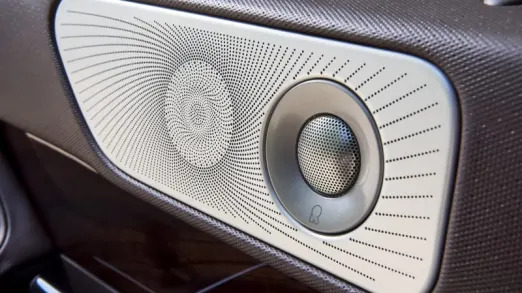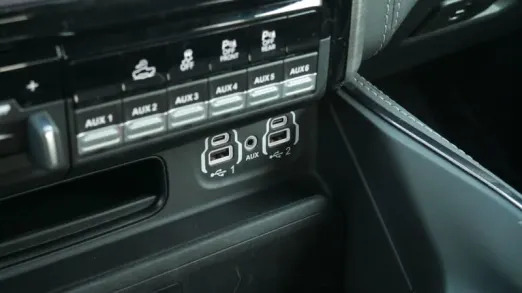With all the technology in new vehicles, it’s easy to overlook the stereo system. But for some – and certainly for music freaks like me – the car interior is the last bastion of uninterrupted music listening in a world full of distractions. The experience is different than enjoying tunes at home or even with high-end headphones since a vehicle interior is akin to a private listening space and, despite inherent wind and road noise, music always seems to sound better with asphalt whizzing by under your feet.
Automakers have stepped up their audio game to the point that ripping out stock components and installing aftermarket gear has become futile for most new-car buyers. While you can always get better sound from the aftermarket, it will cost you more, may permanently alter your vehicle and can cause hassles when you bring your car in for service – all for mostly marginal gains in audio quality. Like squeezing a bit more performance out of your engine, you can quickly reach a point of diminishing returns in terms of cost-benefit ratio.


Audio Arms Race
If you decide to avoid the aftermarket route, when shopping for a new vehicle you really don’t have much choice other than the system that comes standard with the car or a premium system available either as an option or included on higher-end trims. Premium systems generally perform better than standard systems because they typically have more speakers and amplifier power (measured in watts).
Luxury car makers have been engaged in an audio arms race for bragging rights over the greatest number of speakers and highest amplifier power. Despite this, having more speakers and power doesn't always equal better performance.
The latest Mark Levinson system in the fifth-generation Lexus LS, for example, has a 16-channel, 2,400-watt amplifier powering 23 speakers in 16 locations throughout the flagship sedan. While the Mark Levinson systems are indeed among the best-sounding I’ve tested, Acura’s ELS Studio 3D Premium system available in the Acura TLX with "only" 17 speakers and 710 watts outperforms many higher-speaker, higher-powered systems.


It's not all about the brand
Another potentially misleading audio-quality indicator is branding and basing a buying decision only on the speaker logo alone isn't recommended.
Over the last decade or so, automakers have partnered with boutique audiophile brands such as Burmeister in Mercedes-Benz, Meridian in Jaguar-Land Rover vehicles and Revel in Lincoln. But a dirty secret of OEM audio is that components such as amplifiers are sourced from various vendors. A Bang & Olufsen system, for example, may be made up of gear from large automotive suppliers such as Alpine or Panasonic.
While Bose single-handedly invented OEM branded audio almost 40 years ago, it gets a bad rap from audiophiles – no highs, no lows, it must be Bose. But the best Bose systems can be on par with more elite brands, even if some of the company’s car systems can vary widely even within the same automaker’s vehicles.


Speaker Placement and Audio Features
Beyond component specs and brands, also consider how the system is set up. Back in the day, hardcore car audio enthusiasts would go to great lengths – and do major surgery on their vehicle interiors – to get a center-channel speaker in the dash, tweeters in the front-door sail panels or subwoofers up front for better sound.
While center-channel speakers and sail-panel tweeters are now common, only a few automakers, such as Lincoln, offer front-mounted woofers to avoid a disjointed bass-in-the-back sound. Some automakers, such as Land Rover and Acura, also install speakers in the headliner for better sound at each seat. Some are even in the head restraint, as in certain Nissans.
Also look for whether a car audio system has useful sound-shaping features. Many systems use signal processing to tailor the sound to the interior, focusing it for the driver, front-seat passengers or all car occupants. I’m not a fan of the myriad and usually proprietary digital signal processing and virtual surround sound that often adds an artificial tinge to tunes, although some can improve the sound. Most can also, fortunately, be switched off.
Beyond simple bass and treble controls, separate adjustments for midrange and subwoofers are helpful to dial in a better sound. And I like having a graphic equalizer to tweak the sound to my liking, although very few automakers still offer a graphic EQ. BMW is one that does.


Trust Your Ears
Which brings me to my last and best piece of advice when shopping car stereo: trust your ears. At this point I could throw out a bunch of audiophile qualities to look for, such as sound staging, imaging and dynamic headroom – and I’m happy to expound on these and recommend reference recording in the comments section. Ultimately, though, go to a dealer, try out the different systems available and listen for what sounds best to you. Make sure to play the same song from the same source, just as we car and audio system reviewers do. If you're going to pay $1,000 or more for an upgrade stereo, isn't it worth a few minutes of listening to your favorite song a few times?
If you like highly compressed, bass-heavy sound and use low-resolution sources such as basic streaming services, audition a system using that material. On the other hand, if you want the best possible sound, test a system using high-resolution streams such as Tidal, lossless FLAC files that some automaker audio systems support via USB, or a CD – if you still have them or can still find a disc drive in a new vehicle.


Sign in to post
Please sign in to leave a comment.
Continue